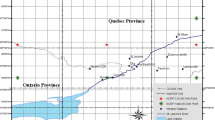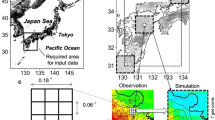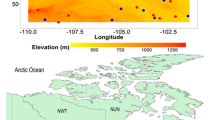Abstract
Seasonally predicted precipitation at a resolution of 2.5° was statistically downscaled to a fine spatial scale of ~20 km over the southeastern United States. The downscaling was conducted for spring and summer, when the fine-scale prediction of precipitation is typically very challenging in this region. We obtained the global model precipitation for downscaling from the National Center for Environmental Prediction/Climate Forecast System (NCEP/CFS) retrospective forecasts. Ten member integration data with time-lagged initial conditions centered on mid- or late February each year were used for downscaling, covering the period from 1987 to 2005. The primary techniques involved in downscaling are Cyclostationary Empirical Orthogonal Function (CSEOF) analysis, multiple regression, and stochastic time series generation. Trained with observations and CFS data, CSEOF and multiple regression facilitated the identification of the statistical relationship between coarse-scale and fine-scale climate variability, leading to improved prediction of climate at a fine resolution. Downscaled precipitation produced seasonal and annual patterns that closely resemble the fine resolution observations. Prediction of long-term variation within two decades was improved by the downscaling in terms of variance, root mean square error, and correlation. Relative to the coarsely resolved unskillful CFS forecasts, the proposed downscaling drove a significant reduction in wet biases, and correlation increased by 0.1–0.5. Categorical predictability of seasonal precipitation and extremes (frequency of heavy rainfall days), measured with the Heidke skill score (HSS), was also improved by the downscaling. For instance, domain averaged HSS for two category predictability by the downscaling are at least 0.20, while the scores by the CFS are near zero and never exceed 0.1. On the other hand, prediction of the frequency of subseasonal dry spells showed limited improvement over half of the Georgia and Alabama region.















Similar content being viewed by others
References
Baigorria GA, Hansen JW, Ward N, Jones JW, O’Brien JJ (2008) Assessing predictability of cotton yields in the southeastern United States based on regional atmospheric circulation and surface temperatures. J Appl Meteor Climatol 47:76–91
Barnston AG (1992) Correspondence among the correlation, RMSE, and Heidke forecast verification measures; Refinement of the Heidke score. Weather Forecast 7:699–709
Cocke S, La Row TE, Shin DW (2007) Seasonal rainfall prediction over the southeast U.S. using the FSU nested regional spectral model. J Geophys Res 112:D04106. doi:10.1029/2006JD007535
Coulibaly P, Dibike YB, Anctil F (2005) Downscaling precipitation and temperature with temporal neural networks. J Hydrometeorology 6:483–496
Cressman GP (1959) An operational objective analysis system. Mon Weather Rev 87:367–374
Duffy PB, Arritt RW, Conquard J, Gutowski W, Han J, Iorio J, Kim J, Leung L-R, Roads J, Zeledon E (2006) Simulations of present and future climates in the western United States with four nested regional climate models. J Clim 19:873–895
Feddersen H, Andersen U (2005) A method for statistical downscaling of seasonal ensemble predictions. Tellus 57A:398–408
Fennessy MJ, Shukla J (2000) Seasonal prediction over North America with a regional model nested in a global model. J Clim 13:2605–2627
Friederichs P, Hense A (2007) Statistical downscaling of extreme precipitation events using censored quantile regression. Mon Weather Rev 135:2365–2378
Fuentes U, Heimann D (2000) An improved statistical-dynamical downscaling scheme and its application to the Alpine precipitation climatology. Theor Appl Climatol 65:119–135
Gershunov A, Barnett T, Cayan D (2003) Heavy daily precipitation frequency over the contiguous United States: sources of climate variability and seasonal predictability. J Clim 16:2752–2765
Giorgi F (1990) Simulation of regional climate using a limited area model nested in a general-circulation model. J Clim 3:941–963
Groisman PY, Legates DR (1994) The accuracy of United States precipitation data. Bull Amer Meteor Soc 75:215–227
Heidke P (1926) Berechnung des Erfolges und der Gute der Windstarkevorhersagen im Sturmwarnungsdienst. Geografts Ann 8:301–349
Hewitson BC, Crane RG (1996) Climate downscaling: techniques and application. Clim Res 7:85–95
Higgins RW, Silva V, Larson J, Shi W (2007) Relationship between climate variability and fluctuations in daily precipitation over the United States. J Clim 15:3561–3579
Higgins RW, Silva VBS, Kousky VE, Shi W (2008) Comparison of daily precipitation statistics for the United States in observations and in the NCEP Climate Forecast System. J Clim. doi:10.1175/2008JCLI2339.1
Hong SY, Leetma A (1999) An evaluation of the NCEP RSM for regional climate modeling. J Clim 12:592–609
Hu Q, Feng S (2001) Variations of teleconnection of ENSO and interannual variation in summer rainfall in the central United States. J Clim 14:2469–2480
Huth R (2002) Statistical downscaling of daily temperature in central Europe. J Clim 15:1731–1742
Huth R, Kysely J (2000) Constructing site-specific climate change scenarios on a monthly scale using statistical downscaling. Theor Appl Climatol 66:13–27
Ji Y, Vernekar AD (1997) Simulation of the Asian summer monsoons of 1987 and 1988 with a regional model nested in a global GCM. J Clim 10:1965–1979
Jolliffe IT, Stephenson DB (2003) Forecast verification: a practitioner’s guide in atmospheric science. Wiley, Hoboken, p 240
Kanamitsu M, Ebisuzaki W, Woollen J, Yang SK, Hnilo JJ, Fiorino M, Potter GL (2002) NCEP-DOE AMIP-II Reanalysis (R-2). Bull Amer Meteor Soc 83:1631–1643
Kim JE, Hong SY (2007) Impact of soil moisture anomalies on summer rainfall over East Asia: a regional climate model study. J Clim 20:5732–5743
Kim KY, North GR (1997) EOFs of harmonizable cyclostationary processes. J Atmos Sci 54:2416–2427
Kim KY, Wu Q (1999) A comparison study of EOF techniques: analysis of nonstationary data with periodic statistics. J Clim 12:185–199
Kim J, Miller NL, Farrara JD, Hong SY (2000) A seasonal precipitation and stream flow hindcast and prediction study in the western United States during the 1997/98 winter season using a dynamic downscaling system. J Hydrometeorology 1:311–329
Leung LR, Qian Y, Bian X (2003) Hydroclimate of the western United States based on observations and regional climate simulation of 1981–2000. Part I: seasonal statistics. J Clim 16:1892–1911
Liang XZ, Pan J, Zhu J, Kunkel KE, Wang JXL, Dai A (2006) Regional climate model downscaling of the U.S. summer climate and future change. J Geophys Res 111:D10108. doi:10.1029/2005JD006685
Lim YK, Kim KY (2006) A new perspective on the climate prediction of Asian summer monsoon precipitation. J Clim 19:4840–4853
Lim YK, Shin DW, Cocke S, La Row TE, Schoof JT, O’Brien JJ, Chassignet EP (2007) Dynamically and statistically downscaled seasonal simulation of maximum surface air temperature over the southeastern United States. J Geophys Res 112:D24102. doi:10.1029/2007JD008764
Mahrt L, Pan HL (1984) A two-layer model of soil hydrology. Bound-Layer Meteorol 29:1–20
Misra V, Dirmeyer PA, Kirtman BP (2003) Dynamical downscaling of seasonal simulations over South America. J Clim 16:103–117
Murphy J (1999) An evaluation of statistical and dynamical techniques for downscaling local climate. J Clim 12:2256–2284
Pandey GR, Cayan DR, Dettinger MD, Georgakakos KP (2000) A hybrid orographic plus statistical model for downscaling daily precipitation in northern California. J Hydrometeorology 1:491–506
Ramírez MCV, Ferreira NJ, Velho HFC (2006) Linear and nonlinear statistical downscaling for rainfall forecasting over southeast Brazil. Weather Forecast 21:969–989
Reusch DB, Alley RB (2002) Automatic weather stations and artificial neural networks: improving the instrumental record in west Antarctica. Mon Weather Rev 130:3037–3053
Robertson AW, Kirshner S, Smyth P (2004) Downscaling of daily rainfall occurrence over northeast Brazil using a hidden Markov model. J Clim 17:4407–4424
Robertson AW, Ines AVM, Hansen JW (2007) Downscaling of seasonal precipitation for crop simulation. J Appl Meteor Climatol 46:677–693
Saha S, Nadiga S, Thiaw C, Wang J, Wang W, Zhang Q, Van den Dool HM, Pan HL, Moorthi S, Behringer D, Stokes D, Peña M, Lord S, White G, Ebisuzaki W, Peng P, Xie P (2006) The NCEP climate forecast system. J Clim 19:3483–3517
Salathé EP (2005) Downscaling simulations of future global climate with application to hydrologic modeling. Int J Climatol 25:419–436
Schmidli J, Goodess CM, Frei C, Haylock MR, Hundecha Y, Ribalaygua J, Schmith T (2007) Statistical and dynamical downscaling of precipitation: an evaluation and comparison of scenarios for the European Alps. J Geophys Res 112:D04105. doi:10.1029/2005JD007026
Schoof JT, Pryor SC (2001) Downscaling temperature and precipitation: a comparison of regression-based methods and artificial neural networks. Int J Climatol 21:773–790
Schoof JT, Shin DW, Cocke S, LaRow TE, Lim YK, O’Brien JJ (2009) Dynamically and statistically downscaled seasonal temperature and precipitation hindcast ensembles for the southeastern USA. Int J Climatol. doi:10.1002/joc.1717
Sun L, Moncunill DF, Li H, Moura AD, Filho FDADS, Zebiak SE (2006) An operational dynamical downscaling prediction system for nordeste Brazil and the 2002–04 real-time forecast evaluation. J Clim 19:1990–2007
Trigo RM, Palutikof JP (2001) Precipitation scenarios over Iberia: a comparison between direct GCM output and different downscaling techniques. J Clim 14:4422–4446
von Storch H, Zorita E, Cubasch U (1993) Downscaling of global climate change estimates to regional scales: an application to Iberian rainfall in wintertime. J Clim 6:1161–1171
Widmann M, Bretherton CS, Salathe EP Jr (2003) Statistical precipitation downscaling over the northwestern United States using numerically simulated precipitation as a predictor. J Clim 16:799–816
Wilby RL, Wigley TML (1997) Downscaling general circulation model output: a review of methods and limitations. Prog Phys Geogr 21:530–548
Wilby RL, Wigley TML, Conway D, Jones PD, Hewitson BC, Main J, Wilks DS (1998) Statistical downscaling of general circulation model output: a comparison of methods. Water Resour Res 34:2995–3008
Wilks DS (1999) Multisite downscaling of daily precipitation with a stochastic weather generator. Clim Res 11:125–136
Wood AW, Maurer EP, Kumar A, Lettenmaier DP (2002) Long-range experimental hydrologic forecasting for the eastern United States. J Geophys Res 107(D20):4429. doi:10.1029/2001JD000659
Wood AW, Kumar A, Lettenmaier DP (2005) A restrospective assessment of National Center for Environmental Prediction climate model-based ensemble hydrologic forecasting in the western United States. J Geophys Res 110:D04105. doi:10.1029/2004JD004508
Acknowledgment
FSU/COAPS receives its base support from the Applied Research Center, funded by NOAA Climate Program Office. We also thank Ms. Meredith Field for her careful proofreading and constructive comments.
Author information
Authors and Affiliations
Corresponding author
Rights and permissions
About this article
Cite this article
Lim, YK., Cocke, S., Shin, D.W. et al. Downscaling large-scale NCEP CFS to resolve fine-scale seasonal precipitation and extremes for the crop growing seasons over the southeastern United States. Clim Dyn 35, 449–471 (2010). https://doi.org/10.1007/s00382-009-0671-z
Received:
Accepted:
Published:
Issue Date:
DOI: https://doi.org/10.1007/s00382-009-0671-z




